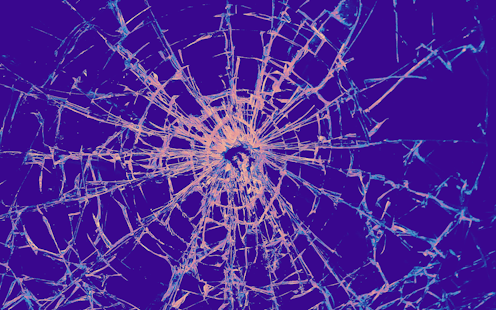in Signs of Damage, Diana Reid explores the depths of the unconscious
- Written by Brigid Magner, Associate Professor in Literary Studies, RMIT University

Signs of Damage is Diana Reid’s third novel, following her bestselling campus romp Love & Virtue and the post-lockdown novel Seeing Other People.
The novel presents itself as a psychological thriller. Its cover – a broken glass vase and a funereal white lily against a black background – signals dark and disturbing subject matter. The publisher’s website describes it as a “gripping tale of unravelling memories and moral ambiguities” that “wrestles with the difference between understanding other people, and trying to explain them”.
The epigraph continues the theme, referring to the depths of the unconscious:
Unexpressed emotions will never die. They are buried alive and will come forth later in ugly ways.
The lines have been attributed (likely misattributed) to Sigmund Freud, though here they are credited to “source unknown”.
Review: Signs of Damage – Diana Reid (Ultimo Press)
The plot moves between Italy in 2008 and Australia in 2024. Death shows up almost immediately. We first meet the protagonist Cass in the prologue. She is in an Italian police station speaking to a coroner about someone’s untimely death. She was present when the person fell from a balcony. Cass claims that she had a seizure immediately before the incident.
We learn that she suffers from psychogenic nonepileptic seizures, which are caused by underlying psychological distress, rather than abnormal electrical activity in the brain. For epileptics, the signs that anticipate a seizure are “so bizarre” they are almost “mystical”, but for Cass the warning sign is comparatively “prosaic”: the smell of burning.
Diana Reid’s novels have been described as a “parcel[s] of activism”. Like her other works, Signs of Damage is preoccupied with skewering privilege, starting with Bruce:
Like most men of his generation, Bruce was only capable of conceiving of his talents as his alone – never the culmination of circumstance. Later in his life, he would learn to say things like, “I’ve been lucky” and “It’s so much harder for young people now” when it became fashionable to do so.
Like many rich people, the Kellys orchestrate their holidays with less fortunate guests for their own amusement. But they can be wilfully oblivious, not understanding or caring what effects they may have on them.
Impressed by the Cambridge credentials of Rupert Tombe, the good-looking crime writer staying in a “haunted” house next door, Bruce invites him to spend time together. Tombe’s name resonates with the darkness of the ice house, which may have held corpses, and his presence triggers sexual jealousy within the group, though Sam, immune to his charms, notes his complete lack of self doubt and the “mocking edge” of his charisma.
Despite his usual breezy confidence, Bruce lies awake in bed worrying about what may have happened in the ice house: “he rolled over and closed his eyes – to the whispers, the cracked shards, the shiny, silvery clues”.
Cass is not the only “poor” outsider on the holiday to pay a price for their relationship with the Kelly family. Also present is Sam, Harry’s defacto guardian. Sam feels moments of fury at these entitled people, who can make a home anywhere: “fly to France and drape themselves by a foreign pool and saunter down a stranger’s staircase”.
Sam is the first person to notice Cass is missing; he becomes her rescuer. He also becomes her life partner, and their backstory establishes the dynamic that reduces Cass to a patient in need of protection, rather than someone who capably manages the challenges of life. It’s not until later that she fully grapples with “life admin”.
Although Signs of Damage is ostensibly a realist novel, it requires the reader to suspend disbelief at times, particularly when it comes to the mystical elements of the plot. The ice house functions as a void in which Cass engages with the deepest recesses of her mind. The seizures she subsequently endures have an almost transcendental dimension, enabling her to fall out of herself into another state. Her loss of memory during these fits, like amnesia in a soap opera, is a classic pretext for generating misunderstandings between characters.
Cass’ psychosomatic epilepsy acts as a disruptive force in the novel, drawing our attention to the (often invisble) machinations of privilege and toxic friendship. Although Cass experiences tragedy – and lives with a dangerous disability – Anika is a more extreme figure, who moves from “mood-bombing” to self harm and supposedly well-meaning manipulation of others.
The title alludes to the ways in which damage can impair judgement and be passed on to others, unless individuals have enough self-awareness to prevent this from happening. Jumping to conclusions and sticking doggedly to unfounded beliefs, the novel suggests, can create untold human wreckage.
In a moment of happiness, Cass reflects generously on Anika’s peculiarities:
Maybe, she thought, that was what love was: knowing people so well that they made sense – not by objective standards, but by behaving in the ways you have come to expect.
But Cass also knows that once a belief has formed in Anika’s mind, there is nothing she can say to convince her otherwise. “Any denials of alleged trauma would be attributed to shame about her illness,” she reflects, “or a lifetime of repression.”
Authors: Brigid Magner, Associate Professor in Literary Studies, RMIT University





